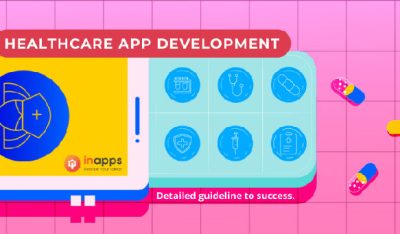- Home
- >
- Offshore News
- >
- Compare Insourcing Vs Outsourcing Cost Analysis Excel
Continuing our previous article, we hope you got a picture of the outsourcing costs before choosing this kind of service from a software vendor. In this part, we will point out the difference between in-house costs and outsourcing costs, more specifically insourcing vs outsourcing cost analysis excel. Also, let’s discover how to calculate outsourcing costs.
If you haven’t read Part 1 yet, check out now: IT Outsourcing Cost: The Ultimate Guide for Entrepreneurs.
1. Insourcing vs outsourcing cost analysis excel
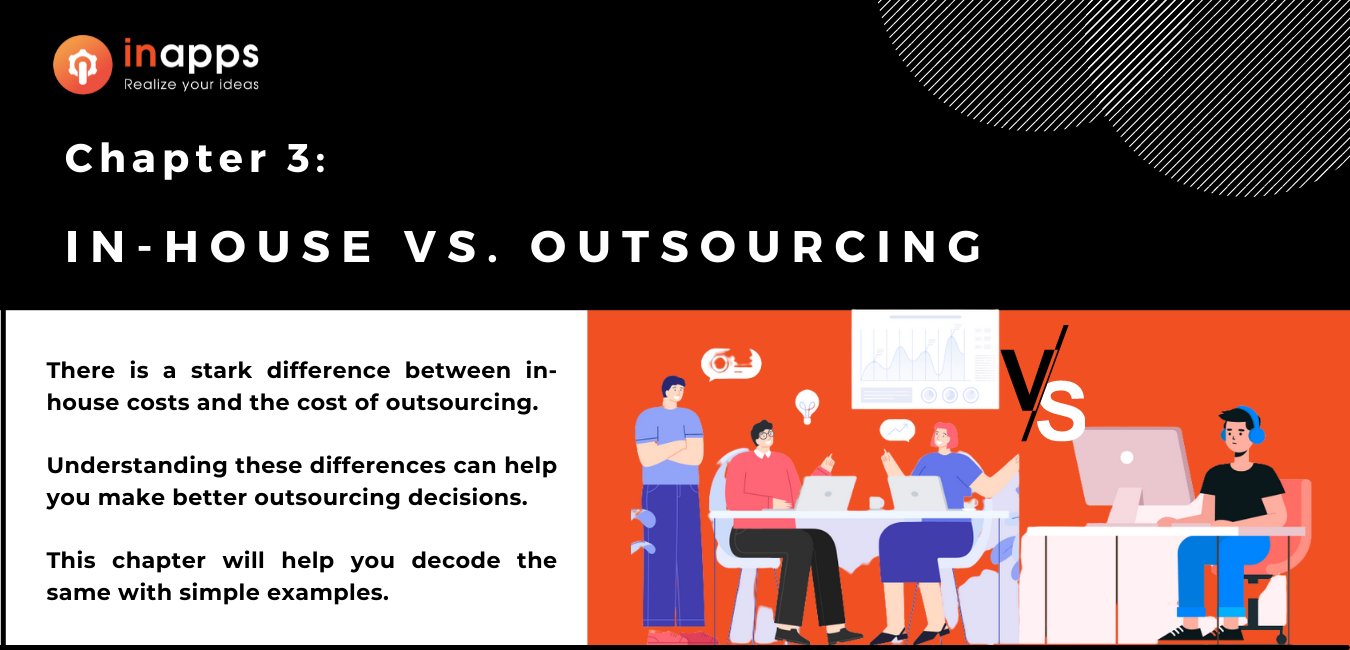
IT outsourcing cost
Deciding whether to outsource IT services can be challenging. Many customers wonder if outsourcing will truly deliver the expected benefits. Imagine you’re planning to outsource your product development. To make an informed decision, you need to compare in-house development costs versus outsourcing.
Building a simple application requires a full team: front-end and back-end developers, UI/UX designers, QA/QC specialists, business analysts, architects, and a project manager. In this case, let’s break down the costs for both in-house and outsourcing options.
1.1 In-House Product Development
Building an in-house development team involves multiple steps, starting with recruiting and reviewing candidates through the human resources team. You will need to hire front-end and back-end developers, UX/UI designers, product architects, quality analysts, and testers.
An advantage of remote developers over in-house developers is the flexibility to avoid long-term contracts. Additionally, in-house developers come with many added costs beyond their salaries. These include paid benefits such as sick leave, annual bonuses, overtime pay, training taxes, and health insurance. You must also provide the necessary infrastructure, workspace, furniture, and refreshments.
Here’s a breakdown of the costs associated with hiring an in-house development team:
- Cost per hire
- Developer salaries
- IT expenses
- Software licenses
- IT systems
- Technology training
- Paid benefits
- General expenses (approximately 25% of salary)
1.2 Outsourcing Product Development
When considering outsourcing for product development, the primary concern is the cost. Let’s explore how much it would cost to hire a remote development team.
Assume we’re building a simple application. This project would require a dedicated team that includes at least three mid-level developers, a designer, and a quality assurance specialist. Additionally, a project manager or SCRUM master would serve as the contact person and a business analyst (BA) would conduct the initial research on the idea.
Read more: How to Lead Your Offshore Team Efficiently.
In comparison with the cost of your in-house team, let’s calculate the number of hours you would hire the offshore team for. A simple product’s basic or MVP version can be completed in 4 sprints around eight weeks. Hiring a development team for two months would add up to 320 hours (8 hours per day multiplied by 5 days per week multiplied by 8 weeks).

IT outsourcing cost
Here’s a breakdown of the costs associated with outsourcing product development:
- Developer fees
- Designer fees
- Quality assurance fees
- Project manager or SCRUM master fees
- Business analyst fees
- Various hidden costs
1.3 Insourcing vs outsourcing cost analysis excel
Below is an example. We have taken the estimated cost of developing your own product and the breakdown of all costs. In addition, we also have the outsourcing costs for the same product development.
[su_table fixed=”yes”]
| Variable | In-House Development Cost In The US (320 hours) | Outsourcing Development Cost To Vietnam (320 hours) |
| Cost per Hire | $4,200 | $1,000 |
| Total Team Salary | $160,000 | $37,100 |
| IT Expenses | $20 | $0 |
| IT Server | Mac: $1,800 | $0 |
| Technology Training Fee | $1,000 | $0 |
| Benefits | $6,500 | $0 |
| Software License | $250 per person | $0 |
| Overhead | $5,000 | $0 |
| Total Cost | $178,770 | $38,100 |
[/su_table]
You can easily deduce how you can save money by outsourcing compared to in-house development from this table. The in-house development team includes various other fees like overheads, increased salary, retention, benefits, and even the cost of hardware and software.
On the other hand, when outsourcing, you only need to pay the remote developer’s salary or offer when hiring an outsourcing agency and optional software license fees if necessary. In fact, outsourcing can save you more than $ 140,000.
As you can see, software outsourcing can certainly help you lower your development costs. It’s not just cost that drives entrepreneurs and startups to outsource, as it gives them:
- Access to a large talent pool that is not locally available
- Provides 24/7 productivity and support
- Promises high-quality codes
- Ensures faster project execution
- Allows entrepreneurs to concentrate more on their core business
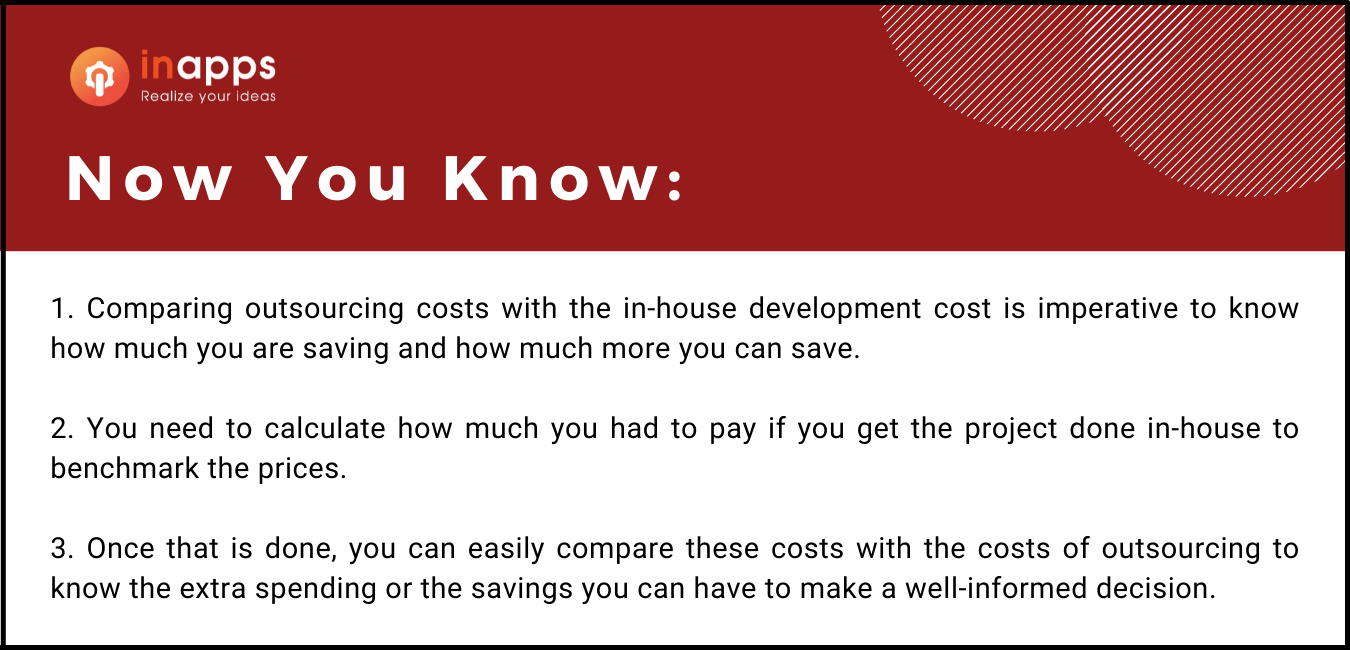
Cost of outsourcing IT services
Learn more: How to mitigate TOP 10 risks of software outsourcing.
2. IT Outsourcing Cost Calculations
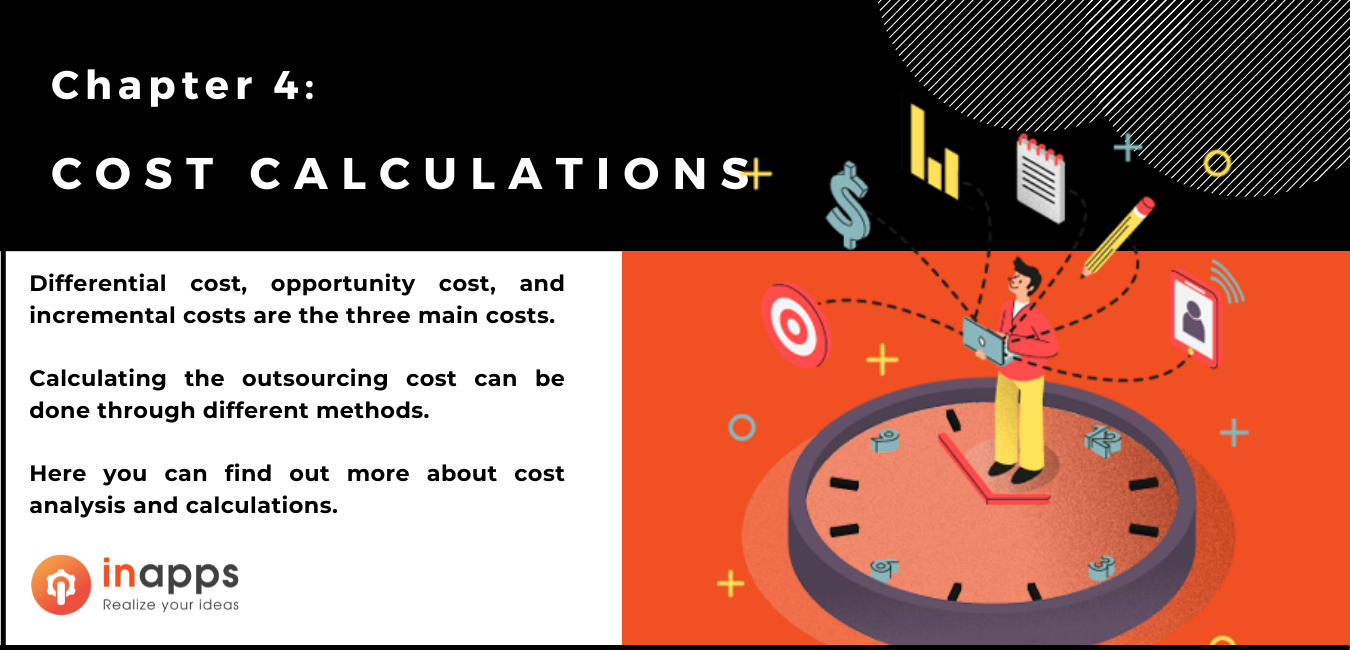
How to calculate outsourcing cost
Calculating the cost of outsourcing would not convince you to turn to outsourcing product development. Of course, you’ll want to dig deeper and learn more about the cost benefits of outsourcing to validate your decision. To analyze the actual cost and cost benefits of outsourcing, we can choose one of three approaches:
- Differential cost analysis
- Opportunity costs
- Incremental costs
Although all three approaches can be used to calculate the cost benefits of outsourcing, the first approach, i.e., differential cost analysis, would give you the exact numbers you are looking for. So here’s a simple 4-step approach to differential cost analysis in outsourcing.
2.1 Differential Cost Analysis
The simplest answer for the question ‘What is differential cost analysis?’ is the amount that is left after you subtract outsourcing costs from in-house costs. But let’s understand this better by considering the costs that we discussed in our product development. Find out the real cost of outsourcing:
#Step 1: Tasks Analysis
The first step is to define the services that you want to outsource clearly. Clearly defined steps and service processes also help you with a better cost analysis.
Here we are developing a product, so we would have to describe all the tasks, such as the target platform, the user interface and user experience (UI and UX), functionality, backend infrastructure, degree of customization, MVP or prototype, creation, performance analysis, etc.
#Step 2: Actual In-House Cost Calculation
The next step would be to calculate how much you would have to spend if you didn’t outsource this operation by first writing down all direct and indirect costs like salaries, benefits, consumables, IT systems, hardware, software, etc. that you would have to provide.
In our product development case, the cost of in-house development was approximately $ 178,770. These costs only include the salary, benefits, IT supplies, training costs, etc., of the developer you would hire.
#Step 3: Outsourcing Cost Calculation
Now that we have the cost of developing a product in-house, the next step is to calculate the total cost of outsourcing services, including everything from the quotation price to any other integrations you may need to do for a smooth transition.
In our case of outsourcing an application, the cost of ownership was approximately $ 41,000. This would be your total IT outsourcing cost.
#Step 4: In-House Cost Minus Outsourcing Cost
This is the final and easiest step in a differential cost analysis of your outsourcing costs. Here it would be:
[su_highlight background=”#FFFF66″]$178,770 – $41,000 = $137,770[/su_highlight]
Well, that certainly ensures that outsourcing cuts costs. Instead of having the product developed in-house, it costs $117,469.
This was just the differential cost analysis method that gave us the numerical value of the amount saved through outsourcing. Let’s look at two more ways to calculate outsourcing costs.
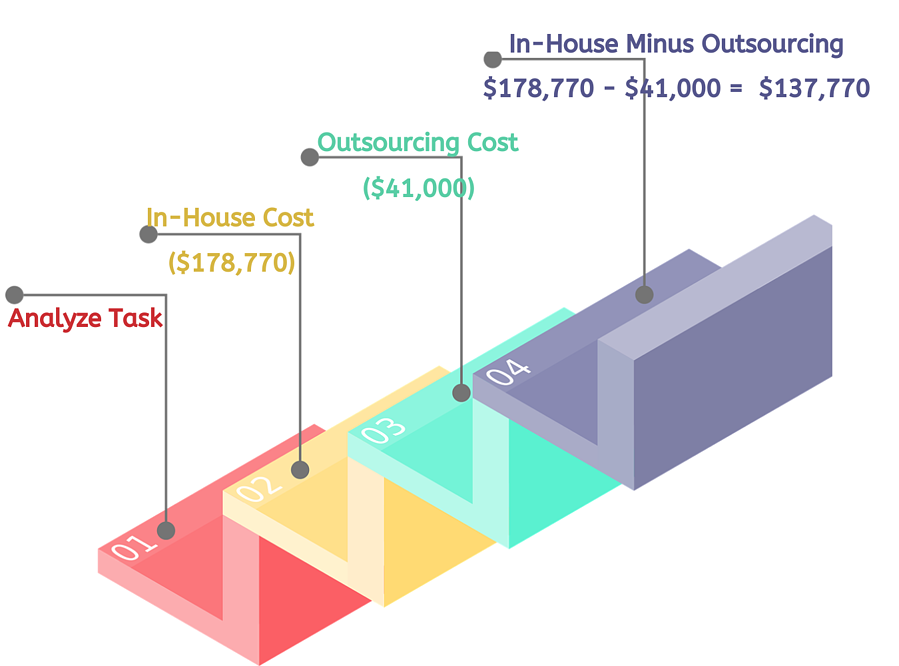
Cost of outsourcing vs inhouse
2.2 Opportunity Cost
Opportunity cost is the cost you could leave if you chose to do the operations in-house rather than outsource development. It could also be the benefit you would otherwise have received but ended up in-house instead of outsourcing.
[su_note]Investopedia Definition: “The cost of an alternative that must be foregone to take a particular action. In other words, the benefits that could have been obtained from an alternative action.”[/su_note]
Let us know how much it will cost your company not to outsource your IT services:
- You cannot concentrate on your core competencies
- Must commit to low-tech skills for your business
- You overload your internal team with multiple tasks and strain them but create no value.
- You are not using your available internal resources to the best of your ability.
2.3 Incremental Cost
Another cost factor many companies overlook when making an outsourcing decision is the additional costs a company incurs in planning to change how they operate and work. The additional cost would be any extra cost that you would have to arise when you outsource your business.
[su_note]Investopedia Definition: “Incremental costs, also known as marginal costs, are the total changes a company experiences in its balance sheet or income statement from the production and sale of an additional unit of product.” [/su_note]
However, based on the calculations in the previous chapter, it can be concluded that the additional costs of subcontracting versus internal would always be negative. Still, if in each case it turns out that the costs of subcontracting are higher than the internal costs, the right way to decide whether or not to want still to outsource is to know how much sales or profit you would make.
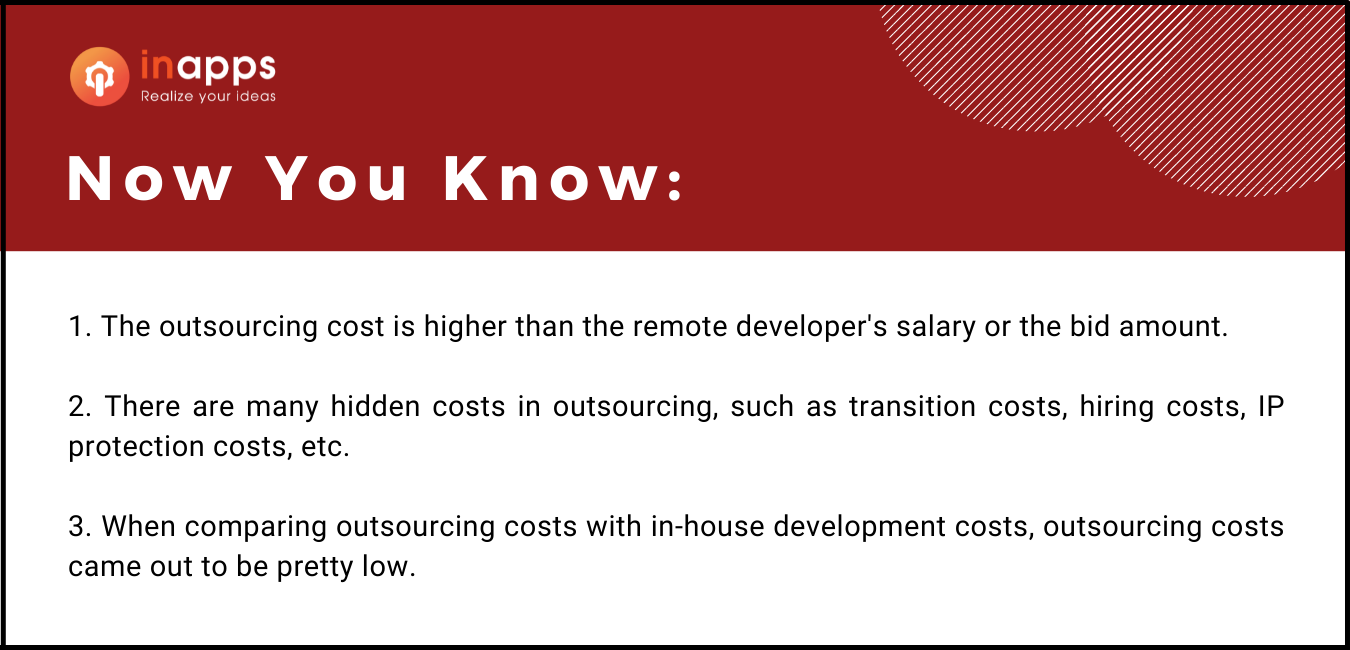
Cost of IT outsourcing
3. Wrap Up
In this article on IT outsourcing costs, we’ve successfully compared in-house and outsourcing costs through a detailed cost analysis using Excel.
For in-house development, costs include recruiting and reviewing candidates, salaries, IT expenses, software licenses, benefits, and general overhead. On the other hand, outsourcing costs primarily involve developer fees, designer fees, quality assurance fees, project management, and business analysis, often leading to significant savings.
Using insourcing vs outsourcing cost analysis excel, we illustrate how outsourcing can save you over $140,000 compared to in-house development. Additionally, we discuss opportunity costs and incremental costs to provide a comprehensive understanding of the financial implications.
This guide helps entrepreneurs and startups understand the potential cost savings, access to a global talent pool, and enhanced productivity that outsourcing can offer.
Read more: Popular Software Outsourcing Models Compared – How to Choose the Best One in 2024?
Let’s create the next big thing together!
Coming together is a beginning. Keeping together is progress. Working together is success.












